Rock Wrasse, Halichoeres semicinctus
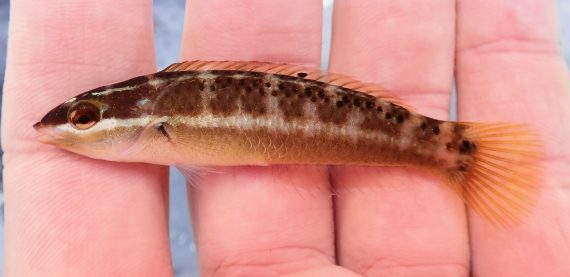 Rock Wrasse, Halichoeres semicinctus, Juvenile. Fish caught from a La Jolla, California tidal pool, December 2018. Length: 7.3 cm (2.9 inches). Catch, photography and identification courtesy of Ben Cantrell, San Diego, California.
Rock Wrasse, Halichoeres semicinctus, Juvenile. Fish caught from a La Jolla, California tidal pool, December 2018. Length: 7.3 cm (2.9 inches). Catch, photography and identification courtesy of Ben Cantrell, San Diego, California.
 Rock Wrasse, Halichoeres semicinctus, Initial Phase (IP), Female. Fish caught from coastal waters within Mission Bay, San Diego, California, January 2020. Length: 15.5 cm (6.1 inches). Catch, photography and identification courtesy of Ben Cantrell, San Diego, California.
Rock Wrasse, Halichoeres semicinctus, Initial Phase (IP), Female. Fish caught from coastal waters within Mission Bay, San Diego, California, January 2020. Length: 15.5 cm (6.1 inches). Catch, photography and identification courtesy of Ben Cantrell, San Diego, California.
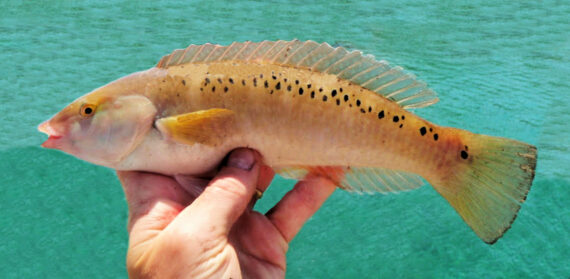 Rock Wrasse, Halichoeres semicinctus, Initial Phase (IP), Female. Fish caught from coastal waters within Mission Bay, San Diego, California, January 2020. Length: 15.5 cm (6.1 inches). Catch, photograph, and identification courtesy of Josh Leisen (joshadventures.com), Gaylord, Michigan.
Rock Wrasse, Halichoeres semicinctus, Initial Phase (IP), Female. Fish caught from coastal waters within Mission Bay, San Diego, California, January 2020. Length: 15.5 cm (6.1 inches). Catch, photograph, and identification courtesy of Josh Leisen (joshadventures.com), Gaylord, Michigan.
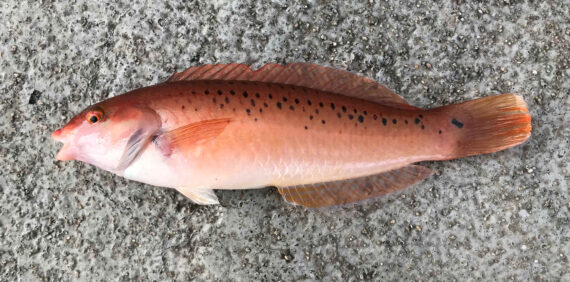 Rock Wrasse, Halichoeres semicinctus, Initial Phase (IP), Female. Fish caught from within Mission Bay, San Diego, California, August 2018. Length: 16 cm (6.3 inches). Catch, photograph and identification courtesy of Luke Ovgard, Klamath Falls, Oregon.
Rock Wrasse, Halichoeres semicinctus, Initial Phase (IP), Female. Fish caught from within Mission Bay, San Diego, California, August 2018. Length: 16 cm (6.3 inches). Catch, photograph and identification courtesy of Luke Ovgard, Klamath Falls, Oregon.
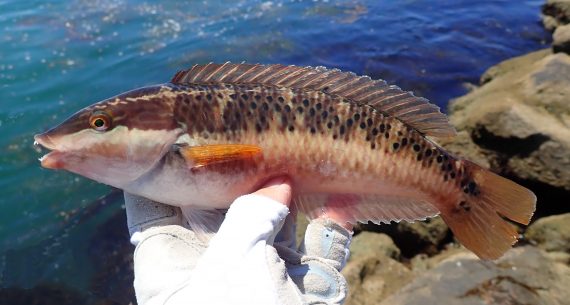 Rock Wrasse, Halichoeres semicinctus, Initial Phase (IP), Female Transitioning to Terminal Phase (TP) Male. Fish caught from with Mission Bay, San Diego, California, August 2019. Length: 16.1 cm (6.3 inches). Catch, photography and identification courtesy of Ben Cantrell, San Diego, California.
Rock Wrasse, Halichoeres semicinctus, Initial Phase (IP), Female Transitioning to Terminal Phase (TP) Male. Fish caught from with Mission Bay, San Diego, California, August 2019. Length: 16.1 cm (6.3 inches). Catch, photography and identification courtesy of Ben Cantrell, San Diego, California.
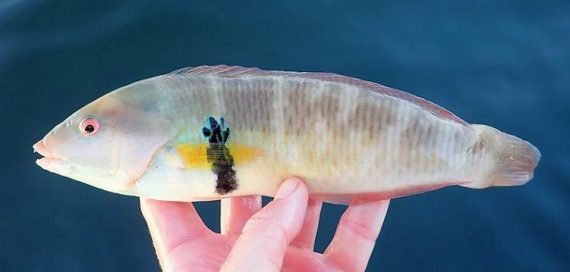 Rock Wrasse, Halichoeres semicinctus, Terminal Phase (TP) Male. Fish caught from coastal waters off Long Beach, California, November 2017. Length: 17 cm (6.7 inches). Catch, photograph and identification courtesy of Ben Cantrell, San Diego, California.
Rock Wrasse, Halichoeres semicinctus, Terminal Phase (TP) Male. Fish caught from coastal waters off Long Beach, California, November 2017. Length: 17 cm (6.7 inches). Catch, photograph and identification courtesy of Ben Cantrell, San Diego, California.
 Rock Wrasse, Halichoeres semicinctus, Terminal Phase (TP) Male. Fish caught from coastal waters off La Bocana, Baja California Sur, October 2015. Length: 18 cm (7.1 inches). Catch and photograph courtesy of George Brinkman, Guelph, Ontario, Canada.
Rock Wrasse, Halichoeres semicinctus, Terminal Phase (TP) Male. Fish caught from coastal waters off La Bocana, Baja California Sur, October 2015. Length: 18 cm (7.1 inches). Catch and photograph courtesy of George Brinkman, Guelph, Ontario, Canada.
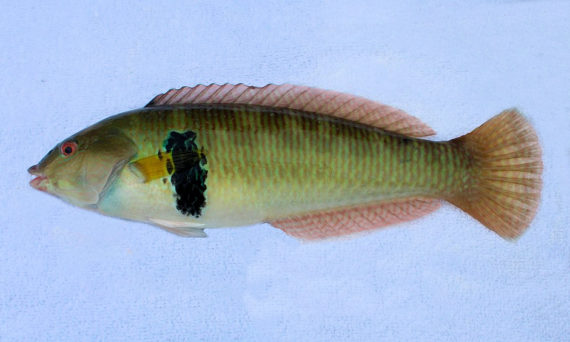 Rock Wrasse, Halichoeres semicinctus, Terminal Phase (TP) Male. Fish caught from coastal waters off Avalon, Santa Catalina Island, California, June 2017. Length: 25 cm (9.8 inches). Catch, photograph and identification courtesy of Ben Cantrell, Peoria, Illinois.
Rock Wrasse, Halichoeres semicinctus, Terminal Phase (TP) Male. Fish caught from coastal waters off Avalon, Santa Catalina Island, California, June 2017. Length: 25 cm (9.8 inches). Catch, photograph and identification courtesy of Ben Cantrell, Peoria, Illinois.
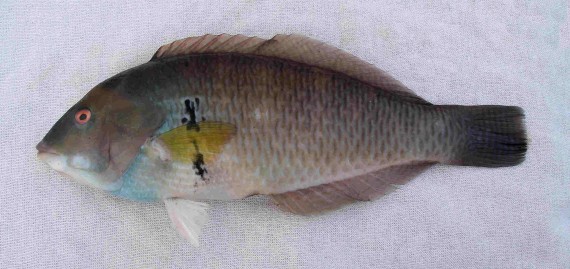 Rock Wrasse, Halichoeres semicinctus, Terminal Phase (TP) Male. Fish provided by the commercial fishermen of the greater Los Cabos area, Baja California Sur, June 2011. Length: 27 cm (10.6 inches).
Rock Wrasse, Halichoeres semicinctus, Terminal Phase (TP) Male. Fish provided by the commercial fishermen of the greater Los Cabos area, Baja California Sur, June 2011. Length: 27 cm (10.6 inches).
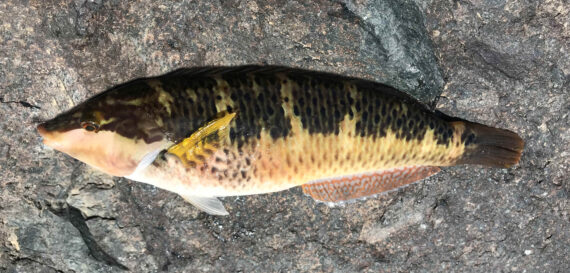 Rock Wrasse, Halichoeres semicinctus, Terminal Phase (TP), Male. Fish caught from within Mission Bay, San Diego, California, August 2018. Length: 16 cm (6.3 inches). Catch, photograph and identification courtesy of Luke Ovgard, Klamath Falls, Oregon.
Rock Wrasse, Halichoeres semicinctus, Terminal Phase (TP), Male. Fish caught from within Mission Bay, San Diego, California, August 2018. Length: 16 cm (6.3 inches). Catch, photograph and identification courtesy of Luke Ovgard, Klamath Falls, Oregon.
The Rock Wrasse, Halichoeres semicinctus, is a member of the Wrasse or Labridae Family, and is known in Mexico as señorita piedrera. Globally, there are seventy species in the genus Halichoeres, of which nineteen are found in Mexican waters, ten in the Atlantic and nine in the Pacific Ocean.
The Rock Wrasse has an elongated compressed body with a depth that is 29% to 34% of standard length; more mature fish have wider bodies. Females and males of the Initial Phase (IP) are pale green to pale yellow-orange with scattered black dots on their upper back. Their fins are similar in color to the body. Terminal Phase (TP) Males are normally longer than 30 cm and similar to IP individuals except that they have a prominent pale-edged black bar mid-body just behind their gill openings. Their fins are similar in color to the body except for the pectoral fins, which are yellow. Juveniles have a white mid-lateral stripe and a black ocellated spot in the middle of their dorsal fin. They have a small terminal mouth equipped with 2 pairs of enlarged canine teeth at the front of both jaws and a prominent large canine tooth at the rear of their top jaw. Their anal fin has 3 spines and 12 rays; their caudal fin is straight or slightly rounded; and, their dorsal fin has 9 spines and 11 or 12 rays. They have 8 gill rakers on the lower arch and 12 gill rakers on the upper arch. Their body is covered with large scales.
The Rock Wrasse is are found over sandy or rubble bottoms adjacent to rocky reefs within tidal pools at depths up to 80 m (260 feet). They reach a maximum of 38 cm (15 inches) in length. As of January 1, 2024, the International Game Fish Association world record stood at 0.45 kg (1 lb 0 oz) with the fish caught in coastal waters off Long Beach, California in March 2014. They sleep half-buried in sand at night with their head protruding and are occasionally found stranded by overnight very low tides in the early morning. During the day they forage for small invertebrates. The Rock Wrasse is poorly studied with very limited information available about their lifestyle and behavioral patterns including specific details on age, growth, longevity, movement patterns, diet, habitat use, and reproduction.
The Rock Wrasse is a resident of Mexican waters of the Pacific Ocean but has a limited distribution being found along the entire west coast of Baja and throughout the Sea of Cortez. They are absent from along the coast of the mainland south to Guatemala.
The Rock Wrasse is most likely confused with the Chameleon Wrasse, Halichoeres dispilus (black-blue ringed blotch just below third and fourth dorsal spines) and the Red-shoulder Wrasse, Stethojulis bandanensis (small teeth; thin blue stripes on head and upper back).
From a conservation perspective the Rock Wrasse is currently considered to be of Least Concern with stable, widely distributed populations. They fairly rare and too small to be of interest to most.